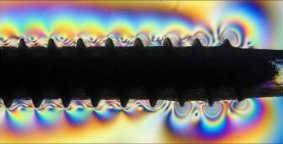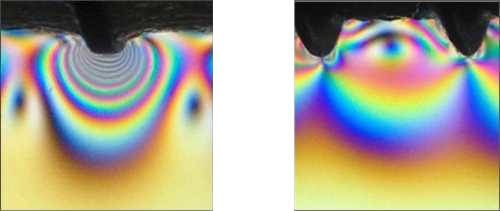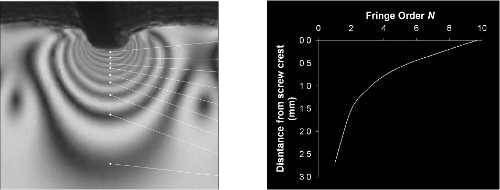Photoelasticity
An optically homogeneous and isotropic birefringent material was developed to study the induced insertion strain of a pedicle screw. Best results were obtained from food grade gelatin in desiccated granular form, which has been used recently with considerable success in the dental research field. Gelatin specimen blocks were carefully molded and pre-drilled to the inside diameter of the pedicle screw, these specimen blocks were then placed inside a circular transmission polariscope. The sample was illuminated with white light and the pedicle screw inserted with images captured every 1/8th of a turn.
By analysing the interference fringes, the difference in magnitude of the in-plane principle strains can be calculated. With the known properties of the gelatin the magnitude of the principle stresses can be determined. Two localised effects were observed with pedicle screw insertion into a gelatin specimen block: contact stresses immediately above/below the crest of the screw threads (left hand image, above); and compression between threads (right hand image, above).
As an example, the fringes produced at the tip of a thread crest are assigned a number – known as fringe order – increasing radially towards the screw. As the pitch of the spacing between fringes decreases towards the thread crest, the differences in principal stresses are increasing at a greater rate with respect to distance, which is indicative of a stress concentration. Analysis of the localised fringe distribution, along with the optical and material properties of the gelatin, allows a quantitative assessment of the stress concentration magnitude to be made. Incremental insertion of a pedicle screw into the birefringent medium permits a detailed stress distribution sequence to be evaluated.
Email Us
Address
Phone
Strain Solutions is registered in England and Wales, company number 05305042





